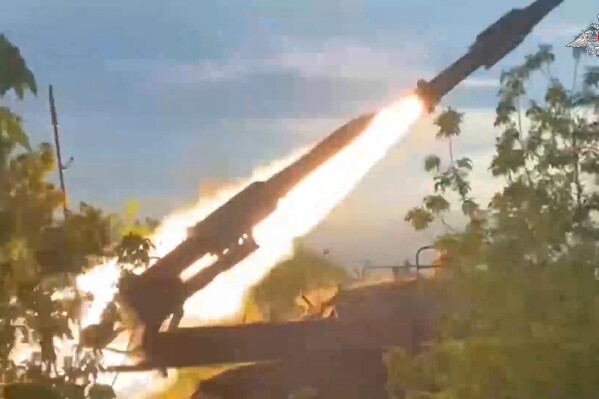How US Surged Forces to Middle East To Keep Iran at Bay
The United States shifted significant naval and air forces to the Middle East this month from bases at home and abroad, adding to 10 months of increased American military presence in the region amid tensions between Israel and Iran.
The latest U.S. military deployments come after the killing of Ismail Haniyeh, Hamas' top political leader, sparked repeated Iranian threats of retaliation against Israel, which has neither confirmed nor denied its involvement in the July 31 airstrike that killed him in Tehran.
The U.S. Defense Department said it surged forces to the Middle East—dozens of advanced fighter jets and two aircraft carriers strike groups—to deter Iran from waging a wider regional war.
As the dust settled over the weekend after an exchange of fire between Israel and the Iran-backed Lebanese Hezbollah group resulted in limited damage to the former, U.S. officials suggested the strategy appeared to be working.
"I think that the additional forces in the theater send a very clear message to all actors in the region that we're serious when it comes to supporting the defense of Israel as well as protecting our forces should they be attacked," Maj. Gen. Pat Ryder, the Pentagon press secretary, said earlier this week.
It was an assessment shared by Gen. Charles Q. Brown, the chairman of the Joint Chiefs of Staff, who told Reuters that both sides appeared to have found an off-ramp following the weekend's missile and drone barrage, one of the biggest clashes since Israel declared war on Hamas and other Iran-backed proxies in response to the October 7 attacks.
Israel was transferred to the U.S. Central Command area of responsibility in 2021 after having previously fallen within the purview of the European Command, or EUCOM. CENTCOM overseas 21 countries spanning 4 million square miles.
On August 2, U.S. Defense Secretary Lloyd Austin ordered the aircraft carrier USS Abraham Lincoln to reposition from the Western Pacific Ocean to the Middle East to relieve the USS Theodore Roosevelt. The directive changed a week later, with the Abraham Lincoln told to expedite its voyage to complement its sister ship's presence.
The Nimitz-class aircraft carriers had sailed separately from Naval Air Station North Island, their home port in San Diego, for scheduled West Pacific deployments in January and July. Both were underway in the Gulf of Oman by the weekend and were expected to remain on station for an indefinite period of time.
The Theodore Roosevelt was in the East China Sea in late June and transited the South China Sea to reach the Arabia Sea about a week later. It replaced the USS Dwight D. Eisenhower, which returned to Naval Station Norfolk in Virginia following nine months of combat missions in and around the Red Sea, making it one of the U.S. Navy's busiest flat-tops in recent years.
The Abraham Lincoln's journey from the Indo-Pacific Command area of responsibility followed a similar route. Its strike group departed Naval Base Guam on August 8 and was in the Malacca Strait a week later.
The retasking of two Pacific-based carriers groups left no U.S. aircraft carriers in the vast Indo-Pacific, the Pentagon's "priority theater," for the first time in two decades. However, a "significant amount" of American naval forces remain in the region, Ryder said.
Also this month, the U.S. Defense Department dispatched the USS Georgia, an Ohio-class submarine armed with up to 154 Tomahawk cruise missiles, to the eastern Mediterranean Sea. The nuclear-powered boat was last seen at Souda Bay, in the Greek island of Crete, on August 5.
At a briefing on Monday, Ryder declined to say whether the Georgia had arrived in the CENTCOM area, noting only that it was "still underway."
The Georgia is expected to follow in the footsteps of the USS Florida, another Ohio-class submarine, which transited the Suez Canal twice in 2023 in calculated shows of force. Last week, Sabrina Singh, the Pentagon's deputy press secretary, said the Georgia's arrival would be "pretty noticeable."
The Georgia and the Florida, among four Ohio-class boats that were converted from nuclear ballistic missile submarines, are stationed at Naval Submarine Base Kings Bay in Georgia. The Florida returned to its home port late last month following a 727-day deployment.
Extra American warships capable of ballistic missile defense, including over a dozen of the Arleigh Burke class, have arrived in the EUCOM and CENTCOM areas as well, according to the Pentagon.
Fox News reported last week that the destroyers USS Arleigh Burke, USS Bulkeley and USS Roosevelt, forward-deployed to Naval Station Rota in the south of Spain, were now in the eastern Mediterranean. They were operating near the amphibious assault ship class leader USS Wasp.
The Wasp Amphibious Ready Group, which reached the area in late June, comprises the San Antonio-class landing ship USS New York and the Harpers Ferry-class landing ship USS Oak Hill, along with an embarked Marine expeditionary unit.
The destroyers USS Laboon and USS Cole shifted from the Gulf of Oman to the Red Sea in the direction of Israel, U.S. defense officials said in early August. Images released by the Navy showed the Laboon arriving at Rota naval base, in Cadiz, on Friday, while the Cole remained on station to protect commercial ships from Yemen's Houthi rebels—another Iran proxy.
The destroyers USS John S. McCain and USS Daniel Inouye are assigned to Carrier Strike Group Nine led by the Theodore Roosevelt, according to the U.S. Naval Institute-run USNI News. The USS Halsey, previously part of the group, returned to its home port Naval Base San Diego two weeks ago, after a seven-month Pacific deployment.
The Abraham Lincoln-led Carrier Strike Group Three comprises the destroyers USS O'Kane, USS Stockdale, USS Spruance, and USS Frank E. Petersen Jr., photos published by the Navy showed. USNI News said the destroyers USS Russell and USS Michael Murphy were operating independently in the Gulf of Oman.
American naval capability in the region is being complemented by a gathering of air power, too. In early August, the Air Force sent an additional fighter squadron to the Middle East, reinforcing defensive operations from nearby friendly airspace. At least a dozen F-22 Raptors, fifth-generation stealth fighter jets, landed in the region as part of the U.S. force posture changes.
The aircraft deployed from Alaska's Joint Base Elmendorf-Richardson in Anchorage, crossed the Canadian Arctic Archipelago and Greenland in the North Atlantic Ocean, stopped at British air force base RAF Lakenheath, then flew across the Mediterranean to reach the Middle East.
At least three other squadrons were deployed to the region before the F-22s: F-15E Strike Eagles from Seymour Johnson Air Force Base in North Carolina, F-16 Fighting Falcons from Aviano Air Base in northern Italy, and A-10 Thunderbolt IIs from Michigan's Selfridge Air National Guard Base, according to the specialist Air and Space Forces Magazine.
The Air Force did not disclose the exact locations of its combat aircraft in the Middle East, but open-source intelligence analysts said the Raptors were likely operating out of Qatar's Al Udeid Air Base, the largest U.S. military base in the region. Posts on X (formerly Twitter), also suggested the Theodore Roosevelt had sent several of its carrier-based F/A-18E/F Super Hornets, each armed with at least eight air-to-air missiles, to Muwaffaq Salti Air Base in Jordan.
Where in the world are U.S. and China's militaries?Read more Where in the world are U.S. and China's militaries?The Air Force has deployed an unknown number of additional KC-135 Stratotanker aerial refueling aircraft from at least half a dozen U.S. or allied air bases to the CENTCOM area, including from MacDill Air Force Base in Florida. Stratotankers are a crucial logistical component of U.S. air operations.
Ryder, the Pentagon spokesperson, said on Tuesday that Hezbollah's attack at the weekend, involving hundreds of rockets and drones, was larger than previous actions. "But it is, in our view, not a wider regional conflict at this stage."
"Iran has made those threats and has said that they intend to retaliate, and so we have to take that very seriously," he said of possible further escalation by Tehran. "And so, we will continue to remain postured, and we are well postured, to be able to support the defense of Israel as well as protect our own forces."
Also on Tuesday, White House national security spokesperson John Kirby told Israel's Channel 12: "Our messaging to Iran is consistent, has been and will stay consistent. One, don't do it. There's no reason to escalate this. There's no reason to potentially start some sort of all-out regional war. And number two, we are going to be prepared to defend Israel if it comes to that."
Kirby was optimistic about a possible Gaza ceasefire deal that could help return the 108 hostages Israel says remain in Hamas captivity.
Disclaimer: The copyright of this article belongs to the original author. Reposting this article is solely for the purpose of information dissemination and does not constitute any investment advice. If there is any infringement, please contact us immediately. We will make corrections or deletions as necessary. Thank you.

